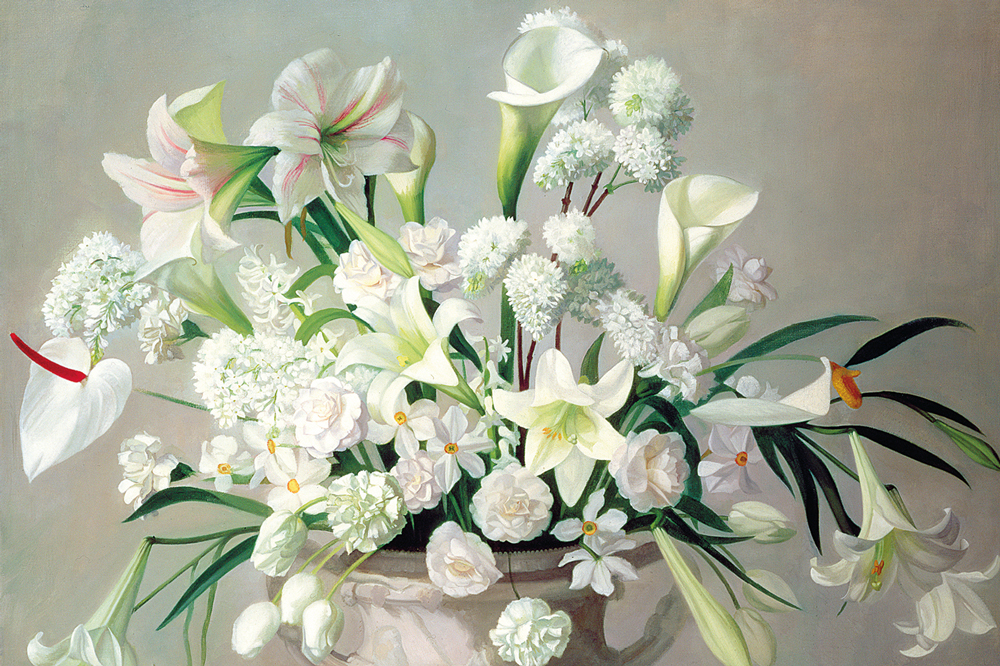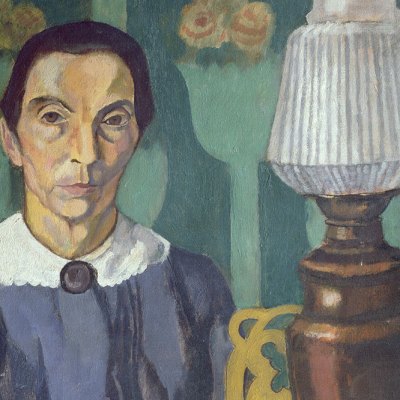This review of This Dark Country: Women Artists, Still Life and Intimacy in the Early Twentieth Century appeared in the October 2021 issue of Apollo. Preview and subscribe here
This impressive collection of essays by Rebecca Birrell about women artists, intimacy and still lives might more cheerfully have been titled ‘Please Do Not TOUCH’. These were the words, we learn, that Vanessa Bell wrote on a card to stop a servant sweeping into the bin a carefully arranged, half-completed nature morte. A sensible precaution. And as an injunction it might also have helped some of the artists discussed here in the avoidance of heartbreak.
However, no; This Dark Country is the serious title of a book with serious work to do, such as redeeming Vanessa Bell’s servants from obscurity. They are named and lauded as the ‘invisible co-producers in the most celebrated decade of Vanessa’s practice. Their names should be on gallery labels.’ Invisible? I thought Bell had literally rendered some visible in paint, but Birrell is on a roll and also disparages Bell’s sign as ‘a message to her servants, who, in her eyes, could not be trusted to distinguish between art and life […] The fear in this command is partly about inconvenience but perhaps more vividly about contamination […] for a servant to touch the apples would be to undo their transformation into a different order of object.’
The Kitchen (c. 1943), Vanessa Bell. © The Charleston Trust

So clever; too clever perhaps. Bloomsbury was about escaping the hierarchies everyone else observed. The author, who once worked in the archives at Charleston, omits to mention Quentin Bell’s plaque over the oven in memory of the cook Grace Higgins, née Germany, ‘a good friend to all Charlestonians’. Perhaps this is because it does not fit her indignant interpretation of Vanessa’s lovely painting of Grace, The Kitchen At Charleston (c. 1943). ‘Who Grace is is incidental: her face and uniform are plain and featureless. Yet for all the eerie disregard that attends the representation of Grace, the image remains one of absolute harmony – a smug kitchen pastoral.’
Although reading this book is rather like touring a gallery with someone who is convinced they are more enlightened than you, there is huge skill in its omnivorous, discursive reading of the paintings, letters, diaries and short stories of the period. Carrington, Ethel Sands, Vanessa Bell, Gluck, Gwen John and Nina Hamnett are each addressed in depth, as the author investigates intimacy in all its forms: domestic, romantic, confessional, habitual. The tone is intimate, too. We are on first name terms with ‘Gwen’, ‘Vanessa’ and the rest – apart from Carrington and Gluck, of course. (The poor author expends several pages handwringing over using ‘her/she’ for Gluck, who always insisted on ‘no prefix, no quotes’ but heartlessly left Birrell no instructions as to pronouns.)
 Gluck painted the vast, grandiose Chromatic (1932) while she courted the florist Constance Spry, who continually sourced new blooms for her so the arrangement retained its perfection for as long as Gluck took to paint it. Birrell reaches effortlessly for apt references. ‘The Argo would prove a fitting resemblance for the bouquet, as Roland Barthes describes the phrase “I love you” as renewing itself alike.’ Society made femininity ‘abject’, apparently, but the marmoreal beauty of the painted flowers here represents women ‘loved, idyllic and flawless’. Like Gluck, the flowers are non-binary, and their folk names are camp (Lords and Ladies, 1936). Like Gluck, their elegance is cultivated (she wore black chiffon culottes from Schiaparelli). Gluck’s greatest love affair, with Nesta Obermer, was spoilt by her obsessiveness, a pattern already rehearsed in the intense, uncomfortable perfection of the flower paintings. Birrell’s thesis is that a still-life painting is a feedback loop that not only reflects the life of its creator, but drives it, creating new dynamics of intimacy.
Gluck painted the vast, grandiose Chromatic (1932) while she courted the florist Constance Spry, who continually sourced new blooms for her so the arrangement retained its perfection for as long as Gluck took to paint it. Birrell reaches effortlessly for apt references. ‘The Argo would prove a fitting resemblance for the bouquet, as Roland Barthes describes the phrase “I love you” as renewing itself alike.’ Society made femininity ‘abject’, apparently, but the marmoreal beauty of the painted flowers here represents women ‘loved, idyllic and flawless’. Like Gluck, the flowers are non-binary, and their folk names are camp (Lords and Ladies, 1936). Like Gluck, their elegance is cultivated (she wore black chiffon culottes from Schiaparelli). Gluck’s greatest love affair, with Nesta Obermer, was spoilt by her obsessiveness, a pattern already rehearsed in the intense, uncomfortable perfection of the flower paintings. Birrell’s thesis is that a still-life painting is a feedback loop that not only reflects the life of its creator, but drives it, creating new dynamics of intimacy.
Ethel Sands’ chic, technically assured interiors are empty, just like the mirror in the story she inspired her friend Virginia Woolf to write, ‘The Lady in the Looking Glass’. Interior with Mirror and Fireplace shows no artist looking back, no traditional male ‘I’m here!’. It is simply one of the most beautiful mirrors in 20th-century art, perfectly ethereal in its ‘pearlescent oyster-shell shimmer’, chosen by this most polished of social hostesses, who kept ambiguous her lifelong relationship with Nan Hudson. Predictably, the author sees this as a failing of society at the time: ‘as a queer woman […] if you wanted to be safe it was necessary to give the impression of not existing at all.’
The essays are interspersed with shorter pieces on lost talents, such as Helen Coombe, Roger Fry’s wife, a Royal Academy painting student who was committed to an institution after suffering post-natal depression, and Edna Waugh, a promising Slade graduate who, through a superficially advantageous marriage, was in her own words ‘put on a pedestal and forgotten’. A sketch reproduced from her archive shows her accomplished hand giving way to desperate, deliquescent doodles. Middle-class marriage and children is, to the author, a dreadful heteronormative abyss and she bitterly notes how Helen signs herself not ‘Helen’ but ‘Mummy’ (this on a letter to her young son).
These types of profiles are never as conclusive as one would wish, but they are original and provide useful context. There are no extant still lifes by Winifred Gill, who ran the Omega workshop for Roger Fry, but she left household recipes, which Birrell bravely tries to cast as ‘verbal still life’. Determined, she describes Winifred’s ruined watercolours, which won’t unroll without tearing, as ‘radiat[ing] defiance. Disinterested in posterity, they insist on not being looked at’. They may also simply have been rolled up before they were completely dry.
Der Sturm (c. 1913), Nina Hamnett. Private collection. Photo: Bridgeman Images

Birrell is committed to art history as a weapon of social justice. She can be wonderfully firm, dismissing Mark Gertler in the middle of a chapter, before he can suck the oxygen from Carrington: ‘[his] chaos is not of interest. Mark’s story ends here.’ She can be fun, imagining a gallery plaque for Rodin that defines him only as Gwen John’s lover. But she expends dreary pages on Nina Hamnett’s still life of 1913 while failing to note that Der Sturm newspaper is placed beside – but crucially not inside – a teacup. Birrell makes a spirited attempt to argue that the end of Nina Hamnett’s life was happy, imagining her illness, penury and alcoholism as willed. ‘Much has been made of the squalor Nina lived in […] as though it were impossible such circumstances might be chosen.’
Over-thinking is a critical vice, but here it comes alongside flashes of real insight into the material concerns that have held back so many women artists. Whatever follows from this author I will read, even if, like the best of gallery companions, she prompts one to differ.
This Dark Country: Women Artists, Still Life and Intimacy in the Early Twentieth Century by Rebecca Birrell is published by Bloomsbury.
From the October 2021 issue of Apollo. Preview and subscribe here.



